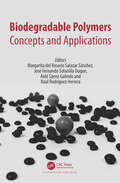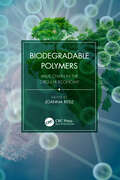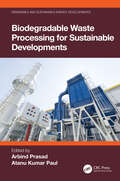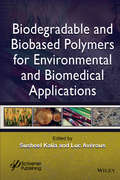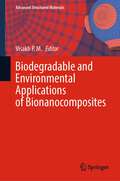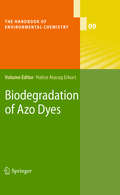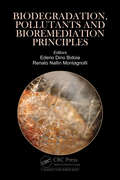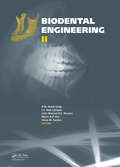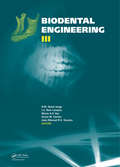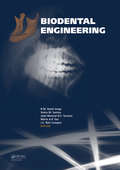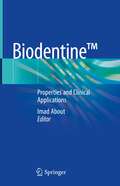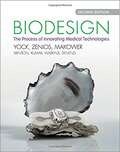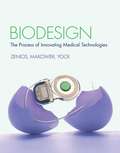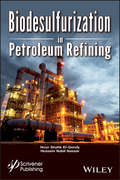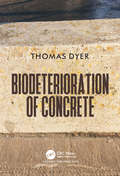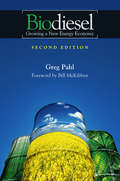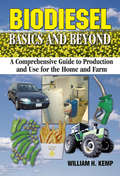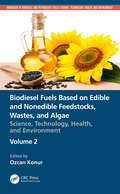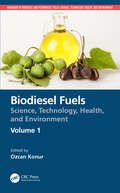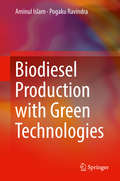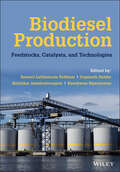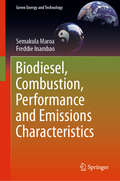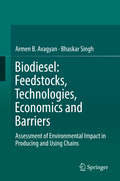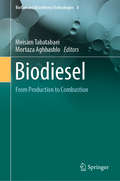- Table View
- List View
Biodegradable Polymers: Concepts and Applications
by Raúl José Margarita del Rosario Salazar Sánchez AidéBasic concepts on biodegradable biopolymer science are presented in this book, as well as techniques, analyses, standards, and essential criteria for the characterization of biodegradable materials obtained from biopolymers. The development and innovation of products and processes considering the environment are highlighted in this book. All of the applications described have been discussed from the point of view of sustainability. Additionally, this book highlights that biodegradability is a great burden when trying to replace, modify, and/or design existing products, and processes that are highly polluting. Finally, the present book concludes with reflections on the development of biopolymers in different areas, and some of their consequences depending on their biodegradability.
Biodegradable Polymers: Value Chain in the Circular Economy
by Joanna RydzStudying (bio)degradable polymers value chain can help one understand the importance of these to the environment and human health. This book provides an overview of the biodegradable polymer along the value chain, identifies and analyses existing practices for biodegradable plastics and assess the relevant legal, regulatory, economic and practical reasons for the importance of proper use and proper recycling of biodegradable plastics. It covers related materials development, environmental impacts, their synthesis by traditional and biotechnological routes, policy and certification, manufacturing processes, (bio)degradable polymer properties and so forth. Features: Gives a clear idea of the present state of the art and future trends in the research of the biodegradable polymers in the context of circular economy. Describes the entire value chain and life cycle of biopolymers, considering different types of polymers. Clarifies the life safety of (bio)degradable polymeric materials. Presents novel opportunities and ideas for developing or improving technologies. Determines the course of degradation during prediction study. This book is aimed at researchers, graduate students and professionals in the polymer processing industry (petrochemical polymer industry, industry producing bio-based and (bio)degradable polymers), food packaging industry, industry involved in waste management, pharma industry, chemical engineering, product engineering and biotechnology.
Biodegradable Waste Processing for Sustainable Developments (Renewable and Sustainable Energy Developments)
by Arbind Prasad, Atanu Kumar PaulThe text comprehensively highlights the key issues surrounding the implementation of waste-to-energy systems, such as site selection, regulatory aspects and financial, and economic implications. It further discusses environmental aspects of food waste to energy conversion, microbial fuel cells (MFCs) for waste recycling and energy production, and valorization of algal blooms and their residues into renewable energy.This book: Discusses the environmental impact of waste-to-energy and sustainable waste-to-energy technologies in a comprehensive manner. Presents life cycle assessment studies and perspective solutions in waste-to-energy sectors. Covers applications of smart materials in thermal energy storage systems. Explains thermo-chemical technologies for recycling plastic waste for energy production and recovery of valuable products. Illustrates biorefineries and case studies for sustainable waste valorization. It is primarily written for senior undergraduate nad graduate students, and academic researchers in the fields of mechanical engineering, environmental engineering, energy studies, production engineering, industrial engineering, and manufacturing engineering.
Biodegradable and Biobased Polymers for Environmental and Biomedical Applications
by Luc Avérous Susheel KaliaThis volume incorporates 13 contributions from renowned experts from the relevant research fields that are related biodegradable and biobased polymers and their environmental and biomedical applications. Specifically, the book highlights: Developments in polyhydroxyalkanoates applications in agriculture, biodegradable packaging material and biomedical field like drug delivery systems, implants, tissue engineering and scaffolds The synthesis and elaboration of cellulose microfibrils from sisal fibres for high performance engineering applications in various sectors such as the automotive and aerospace industries, or for building and construction The different classes and chemical modifications of tannins Electro-activity and applications of Jatropha latex and seed The synthesis, properties and applications of poly(lactic acid) The synthesis, processing and properties of poly(butylene succinate), its copolymers, composites and nanocomposites The different routes for preparation polymers from vegetable oil and the effects of reinforcement and nano-reinforcement on the physical properties of such biobased polymers The different types of modified drug delivery systems together with the concept of the drug delivery matrix for controlled release of drugs and for antitumor drugs The use of nanocellulose as sustainable adsorbents for the removal of water pollutants mainly heavy metal ions, organic molecules, dyes, oil and CO2 The main extraction techniques, structure, properties and different chemical modifications of lignins Proteins and nucleic acids based biopolymers The role of tamarind seed polysaccharide-based multiple-unit systems in sustained drug release
Biodegradable and Environmental Applications of Bionanocomposites (Advanced Structured Materials #177)
by Visakh P. M.This book provides cutting-edge, up-to-date research findings on the use of bionanocomposites in biodegradable and environmental applications, while also detailing how to achieve bionanocomposites preparation, characteristics, and significant enhancements in physical, chemical, mechanical, thermal properties and applications. This book on biodegradable and environmental properties of bionanocomposites provides a comprehensive and updated review of major innovations in the field of polymer-based bionanocomposites for biodegradable and environmental applications. It covers properties and applications, including the synthesis of polymer-based bionanocomposites from different sources biomaterials-based composites and tactics on the efficacy and major challenges associated with successful scale-up fabrication on bionanocomposites.It is an essential reference for future research in bionanocomposites as topics such as sustainable, biodegradable, and environmental methods for highly innovative and applied materials are current topics of importance. The book covers a wide range of research on bionanocomposite and their biodegradable and environmental applications. Updates on the most relevant polymer-based bionanocomposite and their prodigious potential in the fields of biodegradable and the environment are presented. Leading researchers from industry, academy, government, and private research institutions across the globe contribute to this book. Scientists, engineers, and students with interest in the most important advancements in the field of bionanocomposites involving high-performance bionanocomposites will benefit from this book which is highly application-oriented.
Biodegradation and Durability of Materials under the Effect of Microorganisms
by Gennady Zaikov Semenov GumargalievaThis volume in the book series New Concepts in Polymer Science deals with the damaging effects, which microorganisms such as bacteria, fungi, etc. can have on a range of materials in machinery. The book aims to provide theoretical notions about the mechanisms of material damaging by microorganisms under operation conditions as well as to give recom
Biodegradation of Azo Dyes (The Handbook of Environmental Chemistry #9)
by Hatice Atacag ErkurtAzo dyes play an important role as coloring agents in the textile, food, and pharmaceutical industry. Due to the toxicity, mutagenicity and carcinogenicity of azo dyes and their breakdown products, their removal from industrial wastewaters has been an urgent challenge. Promising and cost-effective methods are based on their biodegradation, which is treated in this volume. The topics presented by experts in the field include: the classification of azo dyes; toxicity caused by azo dyes; aerobic and anaerobic azo dye biodegradation mechanisms; the role of bacteria, fungi, algae and their enzymes in biodegradation; the impact of redox mediators on azo dye reduction; the integration of biological with physical and chemical processes; the biotransformation of aromatic amines; reactor modelling for azo dye conversion; the biodegradation of azo dyes by immobilized bacteria and fungi; and factors affecting the complete mineralization of azo dyes.
Biodegradation, Pollutants and Bioremediation Principles
by Ederio Dino BidoiaThis book presents a broad compendium of biodegradation research and discussions on the most up-to-date bioremediation strategies. The most relevant microbiological, biochemical and genetic concepts are presented alongside the fundamentals of bioremediation. The topics include: a wide variety of contaminant impacts evaluation, key methodologies required to measure biodegradation and propose new bioremediation protocols, as well as the handling of microbial communities related to such processes. The selected collaborating authors are renowned for their microbiology expertise and will provide an in-depth reference for students and specialists. The contents provide a valuable source of information for researchers, professionals, and policy makers alike.
Biodental Engineering II
by João Manuel R.S. Tavares R.M. Natal Jorge J.C. Reis Campos Mário A.P. Vaz Sónia M. SantosDentistry is a branch of medicine with its own peculiarities and very diverse areas of action, which means that it can be considered as an interdisciplinary field. BIODENTAL ENGINEERING II contains the full papers presented at the 2nd International Conference on Biodental Engineering (BioDENTAL 2012, Porto, Portugal, 7-8 December 2012). The contrib
Biodental Engineering III
by R.M. Natal Jorge J.C. Reis Campos Mário A.P. Vaz Sónia M. Santos João Manuel R. S. TavaresDentistry is a branch of medicine with its own peculiarities and very diverse areas of action, which means that it can be considered as an interdisciplinary field. Currently the use of new techniques and technologies receives much attention. Biodental Engineering III contains contributions from 13 countries, which were presented at BIODENTAL 2014,
Biodental Engineering: Proceedings Of The 5th International Conference On Biodental Engineering (biodental 2018), June 22-23, 2018, Porto, Portugal
by R.M. Natal Jorge J.C. Reis Campos Sónia M. Santos João Mánuel R.S. Tavares A. P. VazThe aim of Biodental Engineering is to solidify knowledge of bioengineering applied to dentistry. Dentistry is a branch of medicine with its own peculiarities and very diverse areas of action, and in recent years multiple new techniques and technologies have been introduced.This book is a collection of keynote lectures and full papers from Bio
Biodentine™: Properties and Clinical Applications
by Imad AboutThis book is a comprehensive guide to BiodentineTM, an innovative biocompatible and bioactive material based on pure tricalcium silicate that can permanently replace dentin and can also serve as a temporary enamel substitute. Although BiodentineTM has been widely used across the world for the past decade, this is the first book to be devoted to its properties, interactions with the soft and hard tissues, and its multiple clinical applications. The coverage encompasses applications in primary and permanent teeth, in specialties as diverse as restorative dentistry, endodontics, paediatric dentistry, dental traumatology, and prosthetic dentistry. BiodentineTM application both in vital pulp therapy and endodontic procedures is illustrated and clinical step by step protocols are provided. The book provides a detailed update on BiodentineTM use to preserve the pulp vitality in direct/indirect pulp capping, pulpotomy and irreversible pulpitis treatment. It also details BiodentineTM use for non-vital teeth treatment in indications such as root/furcation perforation repair, apexification as well as in regenerative endodontic procedures.BiodentineTM: Properties and Clinical Applications will be a rich source of guidance and information for all dentists as well as dental students and academics.
Biodesign: The Process of Innovating Medical Technologies
by Uday N. Kumar Thomas M. Krummel Stefanos Zenios Josh Makower Lyn Denend Todd J. Brinton Paul G. Yock F. T. Jay Watkins Christine Q. KuriharaThis step-by-step guide to medical technology innovation, now in full color, has been rewritten to reflect recent trends of industry globalization and value-conscious healthcare. Written by a team of medical, engineering, and business experts, the authors provide a comprehensive resource that leads students, researchers, and entrepreneurs through a proven process for the identification, invention, and implementation of new solutions. Case studies on innovative products from around the world, successes and failures, practical advice, and end-of-chapter 'Getting Started' sections encourage readers to learn from real projects and apply important lessons to their own work. A wealth of additional material supports the book, including a collection of nearly one hundred videos created for the second edition, active links to external websites, supplementary appendices, and timely updates on the companion website at ebiodesign.org. Readers can access this material quickly, easily, and at the most relevant point in the text from within the ebook.
Biodesign: The Process of Innovating Medical Technologies
by Uday N. Kumar Thomas M. Krummel Paul Yock Stefanos Zenios Josh Makower Lyn Denend Todd J. BrintonRecognize market opportunities, master the design process, and develop business acumen with this 'how-to' guide to medical technology innovation. A three-step, proven approach to the biodesign innovation process - identify, invent, implement - provides a practical formula for innovation. The experiences of hundreds of innovators and companies, in the form of case studies, quotes and practical advice, offer a realistic, action-orientated roadmap for successful biodesign innovation. Real-world examples, end-of-chapter projects, and Getting Started sections guide the reader through each of the key stages of the process and provide a template to create their own new medical devices. Addressing common medical, engineering, and business challenges to develop well-rounded expertise, this book is the complete package for any biodesign entrepreneur. The text is supported by valuable resources, including up-to-date industry changes: found at ebiodesign.org.
Biodesulfurization in Petroleum Refining
by Nour Shafik El-Gendy Hussein Mohamed NassarPetroleum refining and process engineering is constantly changing. No new refineries are being built, but companies all over the world are still expanding or re-purposing huge percentages of their refineries every year, year after year. Rather than building entirely new plants, companies are spending billions of dollars in the research and development of new processes that can save time and money by being more efficient and environmentally safer. Biodesulfurization is one of those processes, and nowhere else it is covered more thoroughly or with more up-to-date research of the new advances than in this new volume from Wiley-Scrivener. <p><p> Crude oil consists of hydrocarbons, along with other minerals and trace elements. Sulfur is the most abundant element after carbon and hydrogen, then comes after it nitrogen, and they usually concentrated in the higher boiling fractions of the crude oil. The presence of sulfur compounds causes the corrosion of refining facilities and catalysts poisoning. Moreover, the presence of nitrogen-compounds directly impacts the refining processes via; poisoning the cracking catalysts and inhibiting the hydrodesulfurization catalysts. In addition, both have bad impacts on the environment, throughout the sulfur and nitrogen oxide emissions. Removing this sulfur and nitrogen from the refining process protects equipment and the environment and creates a more efficient and cost-effective process. <p> Besides the obvious benefits to biodesulfurization, there are new regulations in place within the industry with which companies will, over the next decade or longer, spend literally tens, if not hundreds, of billions of dollars to comply. Whether for the veteran engineer needing to update his or her library, the beginning engineer just learning about biodesulfurization, or even the student in a chemical engineering class, this outstanding new volume is a must-have. Especially it covers also the bioupgrading of crude oil and its fractions, biodenitrogenation technology and application of nanotechnology on both bio-desulfurization and denitrogenation technologies.
Biodeterioration of Concrete
by Thomas DyerAwareness of the importance of ensuring durability of concrete has been a growing concern of engineers, and there is now considerable understanding of the mechanisms, which cause its deterioration, and means of limiting such damage through the use of appropriate materials and approaches to design. Many of the deterioration mechanisms, which affect concrete, are the result of interaction with the non-living environment – chlorides in seawater, carbon dioxide in the atmosphere, cyclic freezing and thawing. However, living organisms can also cause damage – through both chemical and physical processes - which under the right conditions, can be severe. This book looks at all forms of concrete biodeterioration together for the first time. It examines, from a fundamental starting point, biodeterioration mechanisms, as well as the conditions which allow living organisms (bacteria, fungi, plants and a range of marine organisms) to colonise concrete. A detailed evaluation of chemical compounds produced by living organisms with respect to their interaction with the mineral constituents of concrete, and the implications it has for the integrity of structures, is also included. Approaches to avoiding biodeterioration of concrete are also covered, including selection of materials, mix proportioning, design, and use of protective systems.
Biodiesel
by Greg PahlFor anyone who is trying to keep up with the extremely rapid developments in the biodiesel industry, the second edition of Biodiesel: Growing a New Energy Economy is an invaluable aid. The breathtaking speed with which biodiesel has gained acceptance in the marketplace in the past few years has been exceeded only by the proliferation of biodiesel production facilities around the United States-and the world-only to confront new social and environmental challenges and criticisms. The international survey of the biodiesel industry has been expanded from 40 to more than 80 countries, reflecting the spectacular growth of the industry around the world. This section also tracks the dramatic shifts in the fortunes of the industry that have taken place in some of these nations. The detailed chapters that cover the industry in the United States have also been substantially rewritten to keep abreast of its many new developments and explosive domestic growth. An expanded section on small-scale, local biodiesel production has been added to better represent this small but growing part of the industry. Another new section has been added to more fully explore the increasingly controversial issues of deforestation and food versus fuel, as well as GMO crops. The second edition concludes with updated views on where the industry is headed in the years to come from some of its key players.
Biodiesel Basics and Beyond
by William H. KempBiodiesel Basics and Beyond aims to separate fact from fiction and to educate potential home, farm, and cooperative manufacturers on the economic production of quality biodiesel from both waste and virgin oil feedstock. The book includes: detailed processes and equipment required to produce biodiesel fuel that meets North American standards how farmers can use excess oilseed as a feedstock for biodiesel production the use of the co-byproduct glycerin in the making of soap a guide to numerous reference materials and a list of supplier data This is North America's definitive guide to responsibly producing biodiesel from waste vegetable oil while minimizing your environmental footprint in the process.
Biodiesel Fuels Based on Edible and Nonedible Feedstocks, Wastes, and Algae: Science, Technology, Health, and Environment (Handbook of Biodiesel and Petrodiesel Fuels)
by Ozcan KonurThis second volume of the Handbook of Biodiesel and Petrodiesel Fuels presents a representative sample of the population papers in the field of feedstock-specific biodiesel fuels. The research on feedstocks for biodiesel fuels has first focused on the edible oils as first-generation biodiesel fuels. However, the public concerns about the competition with foods based on these feedstocks and adverse impact on the ecological diversity and deforestation have resulted in the exploration of nonedible-oil-based biodiesel fuels as second-generation biodiesel fuels in the first instance. Due to the ecological and cost benefits of treating wastes, waste oil-based biodiesel fuels as third-generation biodiesel fuels have emerged. Furthermore, following a series of influential review papers, the research has focused on the algal oil-based biodiesel fuels in recent years. Since the cost of feedstocks in general constitutes 85% of the total biodiesel production costs, the research focused more on improving biomass and lipid productivity in these research fields. Furthermore, since water, CO2, and nutrients (primarily N and P) have been major ingredients for the algal biomass and lipid production, the research has also intensified in the use of wastewaters and flue gases for algal biomass production to reduce the ecological burdens and the production costs. Part 1 presents a representative sample of the population papers in the field of edible oil-based biodiesel fuels covering major research fronts. It covers soybean oil-based biodiesel fuels, palm oil-based biodiesel fuels, and rapeseed oil-based biodiesel fuels as case studies besides an overview paper. Part 2 presents a representative sample of the population papers in the field of nonedible oil-based biodiesel fuels covering major research fronts. It covers Jatropha oil-based biodiesel fuels, polanga oil-based biodiesel fuels, and moringa oil-based biodiesel fuels as case studies besides an overview paper. Part 3 presents a representative sample of the population papers in the field of waste oil-based biodiesel fuels covering major research fronts. It covers wastewater sludge-based biodiesel fuels, waste cooking oil-based biodiesel fuels, and microbial oil-based biodiesel fuels as case studies besides an overview paper. Part 4 presents a representative sample of the population papers in the field of algal oil-based biodiesel fuels covering major research fronts. It covers algal biomass production in general, algal biomass production in wastewaters, algal lipid production, hydrothermal liquefaction of algal biomass, algal lipid extraction, and algal biodiesel production besides an overview paper. This book will be useful to academics and professionals in the fields of Energy Fuels, Chemical Engineering, Physical Chemistry, Biotechnology and Applied Microbiology, Environmental Sciences, and Thermodynamics. Ozcan Konur is both a materials scientist and social scientist by training. He has published around 200 journal papers, book chapters, and conference papers. He has focused on the bioenergy and biofuels in recent years. In 2018, he edited ‘Bioenergy and Biofuels’, that brought together the work of over 30 experts in their respective field. He also edited ‘Handbook of Algal Science, Technology, and Medicine’ with a strong section on the algal biofuels in 2020.
Biodiesel Fuels: Science, Technology, Health, and Environment (Handbook of Biodiesel and Petrodiesel Fuels)
by Ozcan KonurThis first volume of the Handbook of Biodiesel and Petrodiesel Fuels presents a representative sample of the population papers in the field of biodiesel fuels in general. Part I provides an overview of the research field on both biodiesel and petrodiesel fuels highlighting primary and secondary research fronts in these fields. Part II presents a representative sample of the population papers in the field of biooils covering major research fronts. The research on the biooils is a fundamental part of the research on the biodiesel fuels. The research in this field has intensified in recent years with the application of advanced catalytic technologies and nanotechnologies in both production and upgrading of biooils. It covers pyrolysis, hydrothermal liquefaction, and upgrading, and characterization and properties of biooils besides an overview of the research field. Part III presents a representative sample of the population papers in the field of biodiesel fuels in general covering major research fronts. The research in this field has progressed in the lines of production, properties, and emissions of biodiesel fuels. As in the case of biooils, catalysts and additives play a crucial role for the biodiesel fuels. It covers biomass-based catalyst-assisted biodiesel production, enzymatic biodiesel production, additives in biodiesel production, properties, characterization, performance, and policies of biodiesel fuels besides an overview of the research field. Part IV presents a representative sample of the population papers in the field of glycerol, biodiesel waste, covering major research fronts. The research in this field has intensified in recent years with the increasing volume of biodiesel fuels, creating eco-friendly solutions for these wastes of biodiesel fuels for producing valuable biofuels and biochemicals from glycerol. It covers biohydrogen and propanediol production from glycerol as a case study for bioenergy and biochemicals, respectively. This book will be useful to academics and professionals in the fields of Energy Fuels, Chemical Engineering, Physical Chemistry, Biotechnology and Applied Microbiology, Environmental Sciences, and Thermodynamics. Ozcan Konur is both a materials scientist and social scientist by training. He has published around 200 journal papers, book chapters, and conference papers. He has focused on the bioenergy and biofuels in recent years. In 2018, he edited Bioenergy and Biofuels, which brought together the work of over 30 experts in their respective field. He also edited the Handbook of Algal Science, Technology, and Medicine with a strong section on the algal biofuels in 2020.
Biodiesel Production with Green Technologies
by Pogaku Ravindra Aminul IslamThis book provides a single-source reference to green technologies in advanced biofuel technology. The main focus is on the description of the state of the art in catalytic processes for the "green" production of biofuels. The authors describe two different, practical approaches for catalysts, which allow for effective and easy separation of the catalyst by simple filtration, and enable reuse for several cycles. Readers will gain understanding as to the mechanisms involved in the synthesis and structure formation of the catalyst, in order to maximize yield of biodiesel production. The authors also address the question of how catalytic material should be distributed inside a porous support to obtain optimal performance. The effects of physicochemical and operating parameters are analyzed to gain insight into the underlying phenomena governing the performance of optimally designed catalysts.
Biodiesel Production: Feedstocks, Catalysts, and Technologies
by Samuel Lalthazuala Rokhum Gopinath Halder Suttichai Assabumrungrat Kanokwan NgaosuwanAn incisive discussion of biofuel production from an economically informed technical perspective that addresses sustainability and commercialization together In Biodiesel Production: Feedstocks, Catalysts and Technologies, renowned chemists Drs Rokhum, Halder, Ngaosuwan and Assabumrungrat present an up-to-date account of the most recent developments, challenges, and trends in biodiesel production. The book addresses select feedstocks, including edible and non-edible oils, waste cooking oil, microalgae, and animal fats, and highlights their advantages and disadvantages from a variety of perspectives. It also discusses several catalysts used in each of their methods of preparation, as well as their synthesis, reactivity, recycling techniques, and stability. The contributions explore recently developed technologies for sustainable production of biodiesel and provides robust treatments of their sustainability, commercialization, and their prospects for future biodiesel production. A thorough introduction to the various catalysts used in the preparation of biodiesel and their characteristics Comprehensive explorations of biofuel production from technical and economic perspectives, with complete treatments of their sustainability and commercialization Practical discussions of the development of new strategies for sustainable and economically viable biodiesel production In-depth examinations of biodiesel feedstocks, catalysts, and technologiesPerfect for academic researchers and industrial scientists working in fields that involve biofuels, bioenergy, catalysis, and materials science, Biodiesel Production: Feedstocks, Catalysts and Technologies will also earn a place in the libraries of bioenergy regulators.
Biodiesel, Combustion, Performance and Emissions Characteristics (Green Energy and Technology)
by Semakula Maroa Freddie InambaoThis book focuses on biodiesel combustion, including biodiesel performance, emissions and control. It brings together a range of international research in combustion studies in order to offer a comprehensive resource for researchers, students and academics alike. The book begins with an introduction to biodiesel combustion, followed by a discussion of NOx formation routes. It then addresses biodiesel production processes and oil feedstocks in detail, discusses the physiochemical properties of biodiesel, and explores the benefits and drawbacks of these properties. Factors influencing the formation of emissions, including NOx emissions, are also dealt with thoroughly. Lastly, the book discusses the mechanisms of pollution and different approaches used to reduce pollutants in connection with biodiesel. Each approach is considered in detail, and diagrams are provided to illustrate the points in line with industry standard control mechanisms.
Biodiesel: Assessment of Environmental Impact in Producing and Using Chains
by Bhaskar Singh Armen B. AvagyanAir pollution policy is closely connected with climate change, public health, energy, transport, trade, and agriculture, and generally speaking, the Earth has been pushed to the brink and the damage is becoming increasingly obvious. The transport sector remains a foremost source of air pollutants – a fact that has stimulated the production of biofuels. This book focuses on the biodiesel industry, and proposes a modification of the entire manufacturing chain that would pave the way for further improvements. Oil derived from oilseed plantations/crops is the most commonly used feedstock for the production of biodiesel. At the same time, the UK’s Royal Academy of Engineering and 178 scientists in the Netherlands have determined that some biofuels, such as diesel produced from food crops, have led to more emissions than those produced by fossil fuels. Accordingly, this book re-evaluates the full cycle of biodiesel production in order to help find optimal solutions. It confirms that the production and use of fertilizers for the cultivation of crop feedstocks generate considerably more GHG emissions compared to the mitigation achieved by using biodiesel. To address this fertilization challenge, projecting future biofuel development requires a scenario in which producers shift to an organic agriculture approach that includes the use of microalgae. Among advanced biofuels, algae’s advantages as a feedstock include the highest conversion of solar energy, and the ability to absorb CO2 and pollutants; as such, it is the better choice for future fuels. With regard to the question of why algae’s benefits have not been capitalized on for biofuel production, our analyses indicate that the sole main barrier to realizing algae’s biofuel potential is ineffective international and governmental policies, which create difficulties in reconciling the goals of economic development and environmental protection.
Biodiesel: From Production to Combustion (Biofuel and Biorefinery Technologies #8)
by Meisam Tabatabaei Mortaza AghbashloThis book presents in-depth information on the state of the art of global biodiesel production and investigates its impact on climate change. Subsequently, it comprehensively discusses biodiesel production in terms of production systems (reactor technologies) as well as biodiesel purification and upgrading technologies. Moreover, the book reviews essential parameters in biodiesel production systems as well as major principles of operation, process control, and trouble-shooting in these systems. Conventional and emerging applications of biodiesel by-products with a view to further economize biodiesel production are also scrutinized. Separate chapters are dedicated to economic risk analysis and critical comparison of biodiesel production systems as well as techno-economical aspects of biodiesel plants. The book also thoroughly investigates the important aspects of biodiesel production and combustion by taking advantage of advanced sustainability analysis tools including life cycle assessment (LCA) and exergy techniques. In closing, the application of Omics technologies in biodiesel production is presented and discussed. This book is relevant to anyone with an interest in renewable, more sustainable fuel and energy solutions.
